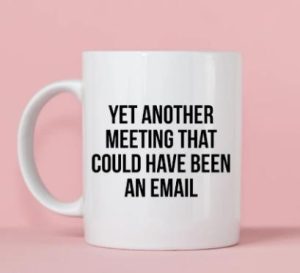Deciding When a Meeting Could Have Been an Email
In today’s business environment, the distinction between when to hold a meeting and when to send an email is more critical than ever. Misjudged communication methods can lead to wasted time, decreased productivity, and frustration among team members. By understanding when a meeting could effectively be replaced by an email, companies can optimize their workflows and enhance overall efficiency.

Evaluate the Purpose of the Interaction
The primary factor in deciding whether to convene a meeting or send an email should always be the purpose of the interaction. Meetings are best suited for complex discussions that require immediate feedback, collaborative thinking, and consensus-building. However, if the purpose is simply to convey information or a straightforward update, an email is usually more appropriate and efficient. Statistics show that companies can save up to 20% of their time by reducing unnecessary meetings, which often could have been concise emails.
Consider the Urgency and Response Time
The urgency of the information and the required response time are crucial considerations. For urgent matters where you need a quick decision or immediate clarification, a brief meeting or a phone call might be more effective. In contrast, for issues that do not require instant feedback, an email allows recipients to respond at their own pace, which can lead to more thoughtful and well-considered replies.
Assess the Need for Personal Interaction
Interpersonal dynamics play a significant role in communication. Some topics, especially sensitive or confidential ones, are better handled in person due to the nuances of human interaction. However, routine updates, general announcements, or standard procedural communications do not typically benefit from face-to-face meetings and can efficiently be managed via email, reducing the average time spent in meetings by approximately 15%.
Determine the Scope of the Audience
If the information is relevant to a large group of people, it’s often more practical to send an email. This ensures that everyone receives the same information and can refer back to it as needed. Meetings with too many participants can become unproductive, as not everyone may need to actively participate. Streamlining communication by selecting the appropriate audience for emails can enhance focus and productivity in the workplace.
Analyze the Potential for Misinterpretation
Emails are great for straightforward, factual communication. However, they lack the tone and nuance of spoken conversation, which can sometimes lead to misunderstandings, especially in complex or emotional contexts. When clarity of expression is critical, and there’s a high potential for misinterpretation, opting for a meeting could be more prudent.
Utilize Technology
Leveraging technology to filter and manage communication can also aid in deciding between meetings and emails. Tools that facilitate task management and project tracking can reduce the need for status update meetings, instead allowing team members to update progress asynchronously via digital platforms.
Learn More About Efficient Communication
For deeper insights into when a meeting could have been an email and tips to avoid unnecessary meetings, visit when a meeting could have been an email.
In conclusion, making the right choice between holding a meeting and sending an email can significantly affect productivity and employee satisfaction. By critically assessing the purpose, urgency, need for interaction, audience scope, and potential for misinterpretation, businesses can ensure that their communication methods are both effective and efficient.